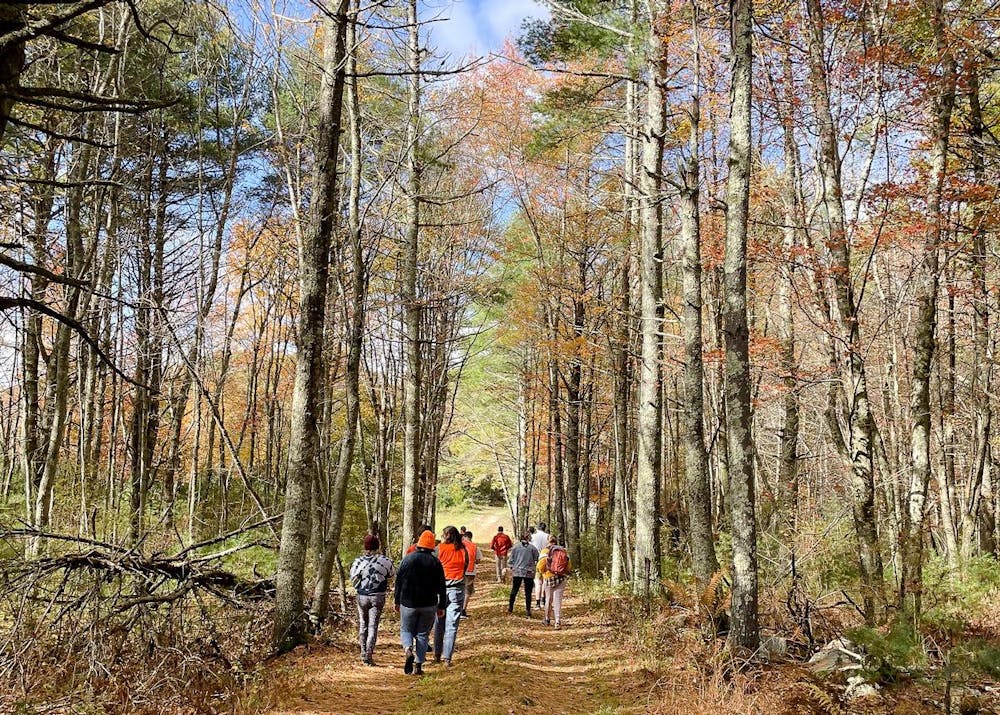On Nov. 30, the Rhode Island Department of Environmental Management and the Rhode Island Forest Conservation Commission hosted a virtual meeting to collect public comments on a draft definition of the state’s most important forests. The public comment period will last until Dec. 8.
Scott Millar, community and technical assistance manager for Grow Smart Rhode Island — a coalition of subject matter experts focused on shaping various city and state policies — and commission chair, began the meeting with a summary of the draft definition.
According to Millar, the definition hopes to outline the various criteria necessary for forestland to be considered part of the state’s “most important forests” — a designation that can be used by municipalities in future land ordinance policies. The proposed definition identifies six types of forests and forested land as “most important.” These include core forests, old-growth forests and urban forests, among others.
At the meeting, Millar said that roughly 56% of the state is currently forested.
Tee Jay Boudreau, deputy chief of RIDEM’s Division of Forest Environment, told The Herald that state legislators can also use the definition to draft future forest conservation legislation.
A coalition charge for conservation legislation
The draft definition follows the Forest Conservation Act of 2021, which charged the Forest Conservation Commission with developing “the criteria necessary for defining the most important forest land.”
According to Kate Sayles, co-coordinator of the Rhode Island Woodland Partnership and vice chair of the commission, the commission began drafting the definition in June 2022 and has been meeting regularly to discuss “various aspects of Rhode Island’s forests, listen to presentations by experts in forest ecology and soils (and) work with RIDEM’s GIS specialist on mapping exercises.”
“We went section by section through various criteria — (old-growth) characteristics, forest connectivity and fragmentation, productive forest soils, rare forest types, proximity to wetlands and protection of drinking water supplies,” she wrote. “We worked with urban forestry professionals to think through and define a set of criteria for those forests … in the U.S. Census Urban Area in RI.”
State Rep. June Speakman (D-Bristol, Warren) sponsored the Forest Conservation Act. According to Speakman, the bill was proposed to her in January 2021 by members of Grow Smart RI.
“As the months went by, it became clear that … there was a broad coalition of support across the environmental community” for the bill, Speakman said.
The Forest Conservation Act was also endorsed in a 2019 report titled “The Value of Rhode Island Forests.” According to Sayles, the report outlines “the current state of Rhode Island’s forests, their benefits and importance and their biggest threats.”
“The report also offers a range of strategies for their conservation, with the first being the passing of a RI Forest Conservation Act,” Sayles wrote in an email to The Herald.
Community members speak out about concerns
At Thursday’s meeting, Warwick resident and retired wetland scientist Michelle Komar voiced concerns about the lack of specificity over the definition’s applications.
“This whole thing about definitions, instead of the whole picture of how they're being used, is incremental work,” said Komar in an interview with The Herald, noting that the commission did not specify the types of regulations the definition would be used for. “It doesn't allow the public to give full comment.”
In her past work experience, “we always have the definitions tied in with the regulations, so you saw how they were being applied and you (could) read the whole document,” she said.
In response to the concerns raised by Komar during the meeting, Boudreau clarified the scope of the commission’s work, saying that the application of the definition is a “much larger” conversation.
According to Millar, the definition will be useful for individuals considering land acquisition or municipalities coming to conservation decisions. “We are giving them that guidance,” he said.
At the meeting, Komar also mentioned reviewing the meeting minutes of the commission and seeing that there was a discussion among commission members on providing a glossary of terms. She noted that the draft definition did not, at the moment, include this glossary and requested the commission provide it for public comment.
In an interview with The Herald, Komar asked: “This glossary refines those definitions, why isn't that included in this public notice?”
For Komar, the commission is not “ready to put this package out for public notice.”
In response, Boudreau clarified that there will be a glossary added to the definition and shared that “all of these terms are identifiable if you do the research on your own.”
At the meeting, Komar asked how much of the state’s forests would fall under the “most important forests” designation. While Boudreau and Millar were unable to answer her question directly, they added that they would work on getting the answer to the public.
Boudreau said that the commission hopes to finalize the definition in January, after incorporating public comments.
Komar noted that she will be asking for an extension on the public comment period.
Looking to the future
Sayles explained that the work of the commission’s “work has just begun” and that the working definition “can be used to prioritize how future funding is directed toward conservation projects.”
“The law also creates a fund that can be utilized to purchase the development rights to forest land,” she wrote. “The Forest Conservation Commission is charged with investigating funding sources to ensure the conservation of RI forests.”
Commission member Marc Tremblay, outreach coordinator for the Rhode Island Forest Conservators’ Organization, said he hopes that the definition will address conservation challenges.
“Not every acre of forest is equal in value,” he said. “There are guidelines that we can come up with, and that's the whole purpose of this most important forest definition.”
According to Speakman, the Forest Conservation Commission works in a larger context of new environmental initiatives happening around the state.
“In the world of environmental policymaking, you have a huge push to stop burning fossil fuels, which means you want to move into renewables and solar,” Speakman said. “But then you bump right up into the forest. So how do you preserve the forests and move aggressively into renewables? It's really hard.”
This year, Johnston residents have pushed back on the construction of a new solar farm due to concerns over forest loss, The Herald previously reported.
“We're trying to find that right balance, “ Speakman said. “It’s not easy.”

Tom Li is the editor-in-chief and president of The Herald's 135th editorial board. He is from Pleasanton, California and studies economics and international and public affairs. He previously served as a metro editor, covering the Health & Environment and Development & Infrastructure beats, and has worked on The Herald's copy editing, editorial page board, design and podcast teams.





